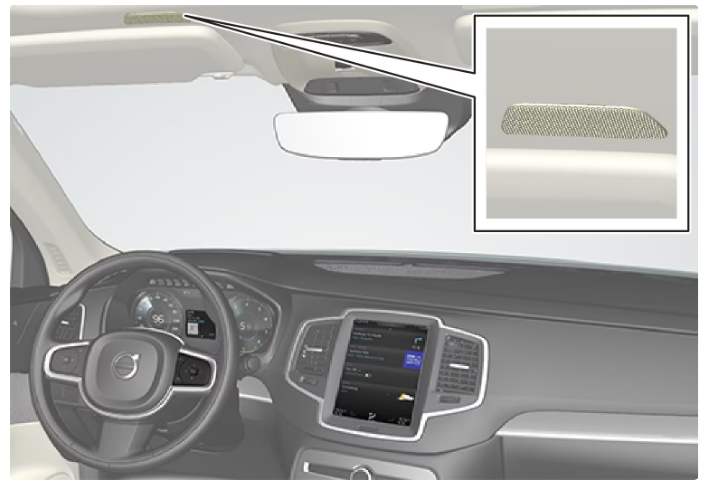2022 XC90 Volvo Voice control

Controlling climate control with voice control
Tap on and say one of the following commands:
- “Climate” – starts a dialogue for climate control and shows examples of commands.
- “Set temperature to X degrees” – sets the desired temperature.
- “Raise temperature“/”Lower temperature” – raise/lower the temperature setting one step.
- “Sync temperature” – synchronises the temperature for all climate zones in the car with the temperature set for the driver’s side.
- “Air on feet“/”Air on body” – opens the desired airflow.
- “Air on feet off“/”Air on body off” – closes the desired air flow.
- “Set fan to max“/”Turn off fan” – changes the air flow to Max/Off.
- “Raise fan speed“/”Lower fan speed” – raises/lowers the fan level one step.
- “Turn on auto” – activates automatic climate regulation.
- “Air condition on“/”Air condition off” – activates/deactivates the air conditioning.
- “Recirculation on“/”Recirculation off” – activates/deactivates the air circulation.
- “Turn on defroster “/”Turn off defroster” – activates/deactivates defrosting of windows and door mirrors.
- “Turn on max defroster“/”Turn max defroster off” – activates/deactivates the max defroster.
- “Turn on electric defroster“/”Turn off electric defroster” – activates/deactivates the heated windscreen.
- “Turn on rear defroster“/”Turn off rear defroster” – activates/deactivates the heated rear window and door mirrors.
- “Turn steering wheel heat on“/”Turn steering wheel heat off” – activates/deactivates the heated steering wheel.
- “Raise steering wheel heat“/”Lower steering wheel heat” – raises/lowers the setting for the heated steering wheel one step.
- “Turn on seat heat“/”Turn off seat heat” – activates/deactivates the heated driver seat.
- “Raise seat heat“/”Lower seat heat” – raises/lowers the setting level for the heated driver seat one step.
- “Turn on seat ventilation“/”Turn off seat ventilation” – activates/deactivates the ventilated driver seat.
- “Raise seat ventilation“/”Lower seat ventilation” – raises/lowers the setting level for the ventilated driver seat one step.
Voice control of radio and media
Tap on and say one of the following commands:
- “Media” – starts a dialogue for media and radio and shows examples of commands.
- “Play [artist]” – plays back music by the selected artist.
- “Play [song title]” – plays back the selected song.
- “Play [song title] from [album]” – plays back the selected song from the selected album.
- “Play [radio station]” – starts playing back the selected radio channel.
- “Tune to [frequency]” – starts the selected radio frequency in the current frequency band. If no radio source is active, the FM band is started by default.
- “Tune to [frequency] [wavelength]” – starts the selected radio frequency in the selected frequency band.
- “Radio” – starts FM radio.
- “Radio FM” – starts FM radio.
- “DAB ” – starts DAB radio.
- “USB” – starts playback from USB.
- “iPod” – starts playback from iPod.
- “Bluetooth” – starts playback from a Bluetooth-connected media source.
- “Similar music” — plays back music similar to the music currently playing back from USB devices.
Voice control
What is voice control?
Voice control is an aid that can facilitate the use of different functions in your car. In order to use voice control, certain specific commands must be used. It may therefore be a good idea to learn how, and in what order, a voice command should be spoken in order to achieve the desired result. The voice control system allows you to control certain infotainment and climate functions using voice commands. The system can respond with speech and by showing information in the driver display.
 Voice control system microphone
Voice control system microphoneSystem updating
The voice control system is continuously improved. It is recommended to always have the latest version installed.
Using voice control
Start voice control

To give commands via the voice control system, you have a “dialogue” with the system. Depress the steering wheel button for voice control to activate the system and initiate a dialogue using voice commands. After you have pressed the button, a beep tone can be heard and the voice control symbol is shown in the driver display. This shows that the system has started to listen and you can start to say the commands. As soon as you start to talk, the system is trained to recognize and understand your voice. This takes several seconds and is done automatically, which means that you do not need to start any voice training manually.
Remember the following:
- Speak after the tone with a normal voice at a normal tempo.
- Do not speak while the system is replying (the system cannot understand commands during this time).
- Avoid background noise in the passenger compartment by having the doors, windows, and panoramic roof closed.
Cancel voice control
Voice control can be canceled in different ways:
- Tap briefly on it and say “Cancel“.
- Give a long press on the steering wheel button for voice control until you hear two beeps. This stops voice control even when the system is speaking.
Voice control is also canceled if you do not reply during a dialogue. The system will first ask for a reply three times and if there is still no response then voice control will be canceled automatically. To speed up communication and skip the prompts from the system, press the steering wheel button for voice control. This cancels the system voice and you can say the next command.
Example of voice control
- Press.
- Say “Call [Forename] [Surname] [number category]“, e.g. “Call Robin Smith Mobile“.
- The system dials the selected contact from the phonebook. If the contact has several phone numbers (e.g. home, mobile, work), the right category must be referred to.
Commands/phrases
The following commands can generally be used, regardless of the situation:
- “Repeat” – repeats the last voice instruction in the ongoing dialogue.
- “Cancel” – discontinue the dialogue.
- “Help” – starts a help dialogue. The system replies with the commands available in the current situation, a prompt, or an example.
Commands for specific functions such as phone and radio are described in specific sections.
Digits
The number commands are stated differently depending on the function to be controlled:
- Phone numbers and postcodes must be spoken individually, number by number, e.g. “zero, three, one, two, two, four, four, three” (03122443).
- House numbers can be spoken individually or in groups, e.g. “two, two” or “twenty-two” (22). For English and Dutch, several groups can be said in sequence, e.g. “twenty-two, twenty-two” (22 22). For English, double or triple can be used, e.g. “double zero” (00). Numbers can be given within the range of 0-2300.
- Frequencies can be spoken as “ninety-eight point eight” (98.8), “a hundred and four points two” or “hundred-four points two” (104.2).
Speed and repetition mode
- It is possible to adjust the speed if the system is speaking too quickly.
- Repetition mode can be enabled so that the system repeats what you have said.
- To change the speed or activate/deactivate repetition mode:
- Press Settings in the top view.
- Press and select settings.
- Repeat Voice Command
- Speech Rate
Updating voice control
Preparations
The new voice control files can be downloaded to an empty USB memory stick of at least 8 GB. The memory must have one of the following formats: FAT32, NTFS or exFAT.
Download
You can find current updates under the tab for download of software on the support site. You access the information for the relevant car by selecting your car and model year. Click on the update that you want to install, then follow the instructions below. Downloads for voice control files are carried out using a program that is installed on your computer.
Instructions
- Depending on which system you have, select the download link for either Windows or Mac.
- Select Run to install the download program.
- Click on New download to download the file to a USB memory stick.
- You can verify that the download/copying to the USB memory stick has worked correctly before you install the file in the car by repeating steps 1-2 and then pressing on Check download in the download program.
- Take the USB memory with the downloaded file to your car and start the infotainment system.
- Insert the USB memory in the USB port. If there are two USB ports, the second one must not be used at the same time.
- The system automatically detects that an update is available and during the update, the screen shows how much of the process remains, counted as a percentage.
- When the installation is complete a notification is shown advising that the updated file is available after the next restart. The USB memory can now be removed.
- If there are any problems with the update, contact your customer support or Volvo dealer.
Updating Tips
- An update takes about half an hour and the infotainment system must be on. Use a battery charger or keep the car’s engine running while the update is in progress, for example during a journey.
- New voice control files for download are launched twice a year
Tips for improving voice control
If the voice control system does not respond as you expect, this may be due to a number of factors. Examples of these include:
- Make sure you are speaking the language that is selected as the system language, and that the language you have selected is supported by voice control.
- Try saying “Help“. You will then receive guidance about what is possible to say. It is possible that the system does not support the phrase that you think the system does not understand.
- Speak at a natural pace and using a normal conversational tone. Do not speak more slowly because the system does not understand you, this impairs recognition.
- Remember that in certain situations, the system has to search through a large database in order to give you the right feedback. In these situations, it is more difficult to give you exactly the right response. A list of possible responses is then often shown on the car’s display.
- The voice control system in your car is under continuous improvement. You can download updated files yourself.
Settings for voice control
Settings can be made within the following areas:
- Repeat Voice Command
- Gender
- Speech Rate
Sound settings
- Select sound settings under:
Language settings
- Voice control is not possible for all languages. Languages available for voice control are marked with an icon in the language list – .
- Changing the language also affects the menu, message, and help texts.
Press on the right-hand keypad on the steering wheel and say one of the following commands:
- “Navigation” – Initiates a navigation dialogue and shows examples of commands.
- “Take me home” – Guidance is given to the Home position.
- “Go to [City]” – Specifies a city as a destination. Example “Drive to London”.
- “Go to [Address]” – Specifies an address as a destination. An address must contain the city and street. Example “Drive to 5 King’s Road, London”.
- “Add intersection” – Starts a dialogue where two streets must be specified. The intersection point of the specified streets then becomes the destination.
- “Go to [Post code]” – Specifies a postcode as a destination. Example “Drive to 1 2 3 4 5”.
- “Go to [contact]” – Specifies an address from the phone book as a destination. Example “Drive to Robyn Smith”.
- “Search [POI category]” – Searches for adjacent points of interest (POI) within a certain category (e.g. restaurants). To have the list sorted along the route – say “Along the route” when the results list is shown.
- “Search [POI category] in [City]” – Searches for points of interest (POI) within a certain category and city. The list of results is sorted according to the city’s central point. Example “Search for a restaurant in London”.
- “Search [POI name]“. Example “Search Kielder Forest”.
- “Change country/Change state,” – Changes the search area for navigation.
- “Show favorites” – Shows saved positions in the driver display.
- “Clear itinerary” – Erases all the stored intermediate destinations and final destinations in an itinerary.
- “Repeat voice guidance” – Repeats the last spoken guidance.
- “Turn off voice guidance” – Switches off voice guidance.
- “Turn on voice guidance” – Starts the switched-off voice guidance.
The following commands can generally be used, regardless of the situation:
- “Repeat” – repeats the last voice instruction in the ongoing dialogue.
- “Help” – starts a help dialogue. The system replies with the commands available in the current situation, a prompt, or an example.
- It is possible to stop voice control both when the system is silent and when it is speaking.
- “Cancel” – stops the dialogue when the system is silent.
- Give a long press on until two beep tones are heard – the dialogue stops, even if the system is speaking.
Addresses
When an address is entered, the search area is defined as the search area preset in the navigation system. It is possible to switch to a different search area. If the new search area uses a different language than the selected system language, the system will automatically switch to a different recognition engine. Therefore, state the address in the language used in the new search area.
Controlling a telephone with voice control
To specify a contact in the phone book, the voice control command must include contact information that is entered in the phone book. If a contact, e.g. Robyn Smith, has several phone numbers then the number category can also be stated, e.g. Home or Mobile: “Call Robin Smith Mobile“.
Press and say one of the following commands:
- “Call [contact]” – dials the selected contact from the phone book.
- “Call [phone number]” – dials the phone number.
- “Recent calls” – displays the call list.
- “Read message” – the message is read out. If there are several messages – select which message should be read out.
- “Message to [contact]” – the user is prompted to speak a short message. The message is then repeated aloud and the user can choose to send or revise the message. For this function to work, the car must be connected to the Internet.
Note
Not all system languages support voice recognition. The ones that do are highlighted with the symbol in the list of available system languages. Read more about where the information can be found in the section on settings for voice recognition.
Voice control of text messages
Reading out text messages
Settings and menus in the center display vary depending on the software version.
You need to connect a mobile phone to the car before you can use voice commands for a mobile phone’s functions (text messages, phone calls, and media player).
To read out a text message, press the voice control button on the right-hand side of the steering wheel and say “Read message“.
Reading out text messages from an iPhone
- To read out text messages from an iPhone, you need to change a setting on your phone so that messages can be sent from the phone to the car.
- Go to Settings.
- Select Bluetooth.
- Click on the info symbol (i) for the connection to your car.
- Switch on Show notes.
Here you can find an introduction to how to start to use voice control in order to control the navigation system in the car.
Press the voice control button on the steering wheel.
You can now give commands, e.g. “Navigation” that start a navigation dialogue and show examples of commands.
Use voice control to get directions to an address
To get directions to a specific address, use the spoken command Go to followed by the address. The order in which the address is given is important. To get directions to an address via voice control, the address must be given in the following order: (1) street address; (2) street number; (3) city; according to the following example:
- Give the Go to command.
- Now you can give the address you want directions to.
- Give the street address, e.g. “King Street”
- Give the street number, e.g. “Five”
- Give the city, e.g. “Gothenburg”
- In this case, the combined command will then be: “Go to King Street Five, Gothenburg”. Provided the address is found in the system, you will now get directions to the address via your navigation system.
Use voice control to get directions to an address in another country or another county
- Your navigation system installs sets of maps for the country or county where the car recognizes its location.
- This means that in order to get correct directions across country or county borders, you need to first tell the system the country or county in which your desired destination address is located.
- You do this by using the Change country or Change state command.
- (The Change state command is primarily used in the USA. The Change country command is used in the example below.)
- Give the Change country command.
- Now you can give the country for the address to which you want directions, e.g. “Norway”.
- Now give the address to which you want directions by following the same procedure as in “Use voice control to get directions to an address”.
- In this scenario, the combined command will be divided into 2 subcommands:
- “Change country, Norway”
- “Go to Karl Johans gate twenty-two, Oslo”
Provided the address is found in the system, you will now get directions to Karl Johans gate 22, Oslo, Norway via your navigation system
Use voice control to get directions to an address given as the Home position
If you have given an address in your navigation system as a Home position, you can use a spoken command to get directions to the position.
Give the Take me home command.
If the navigation system has a home position saved, you will now get directions to the position.
Use voice control to get directions to a place, shop, or other specific business without giving an exact address
You can use your navigation system to get directions to special places or a specific type of business, so-called points of interest (POI). Examples of points of interest are, for example, restaurants, hotels, petrol stations, museums or sights, and landmarks. You use the Search command to search for a point of interest. You can search for both a specific point of interest as well as point of interest categories.
Note
It is important which command you choose to use for obtaining directions to different alternatives. Please note that when you want directions to a point of interest, use the Search command. This is different from when you want directions to specific addresses. Then the Go to command must be used instead.
Search for a specific place or business
[POI name] here refers to a specific place or business, a so-called point of interest, e.g. a hotel, a restaurant, a municipal park, etc.
Give the Search command.
Now you can specify a specific point of interest you want directions to.
State [POI name], e.g. “Castle Forest”
In this case, the combined command will then be: “Search Castle Forest”. Provided the place is found in the system, you will now get directions to the place via your navigation system.
Search for a point of interest category e.g. shops, hotels, restaurants, museums, or other sights and landmarks or businesses
- [POI category] here refers to specific types of places or businesses, so-called points of interest, e.g. hotels, restaurants, museums, etc.
- Give the Search command.
- Now you can specify the type of point of interest you want to find and get directions to.
- State [POI category], e.g. “restaurant”
- In this case, the combined command will then be: “Search restaurant”.
- The navigation system will now search for restaurants located near and around the car, which results in a list on your driver display.
- The list that appears consists of suggestions the system has produced based on your command.
- Categories and close results are at the top, and the lower the relevance a suggestion is deemed to have, the lower down the list it appears.
- Since you are looking for a category in this example, it may be a good idea to choose the category option closest to your search.
- Select the category most appropriate for your search target in the list, in this case, “restaurant(s)”, by speaking the number of the row in which the option appears in the driver display.
- Now you can see your search results and select an option that suits you.
Use voice control to stop directions
- If you want to stop directions and all of the intermediate destinations and the final destination, this can be done with a spoken command.
- Give the Clear itinerary command.
- The navigation system stops the directions and deletes all of the intermediate destinations and the final destination along the travel itinerary.
How to give the postcode and house number
The number commands are stated differently depending on the function to be controlled:
- Postcodes must be spoken individually, number by number, e.g. zero three one two two four four three (03122443).
- House numbers can be spoken individually or in groups, e.g. two or twenty-two (22). For some languages, it is also possible to state them with hundreds, e.g. 19 hundred 22 (1922). For English and Dutch, several groups can be said in sequence, e.g. twenty-two (22 22). For English, double or triple can be used, e.g. double zero (00). Numbers can be given within the range of 0-2300.
Set destination using the phone book’s contact list
If you want to set the address for a contact in the phone’s phone book as a destination then you can do this with the “Go to [contact]” command. However, for the address to be found in the database requires that the address is entered with the correct spelling and without abbreviations. To spell-check addresses in the HEREs database, go to wego.here.com

